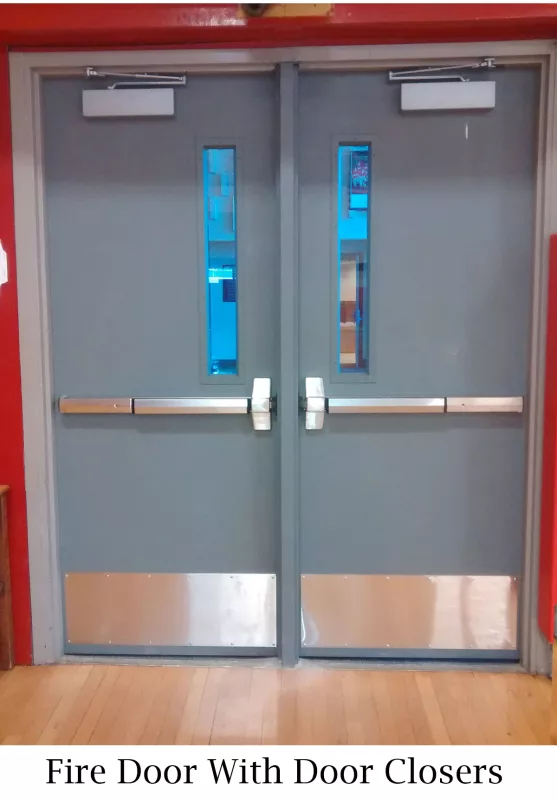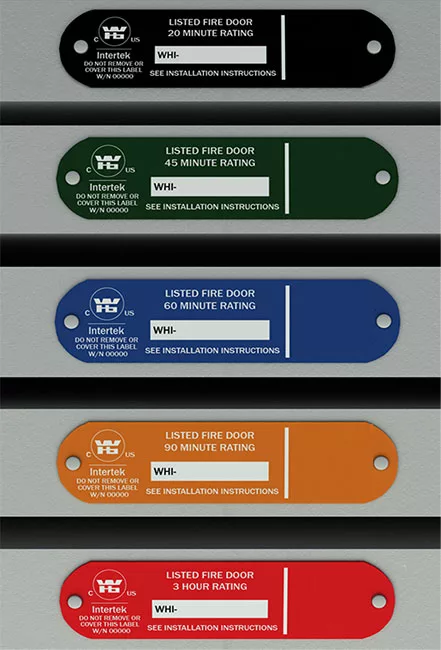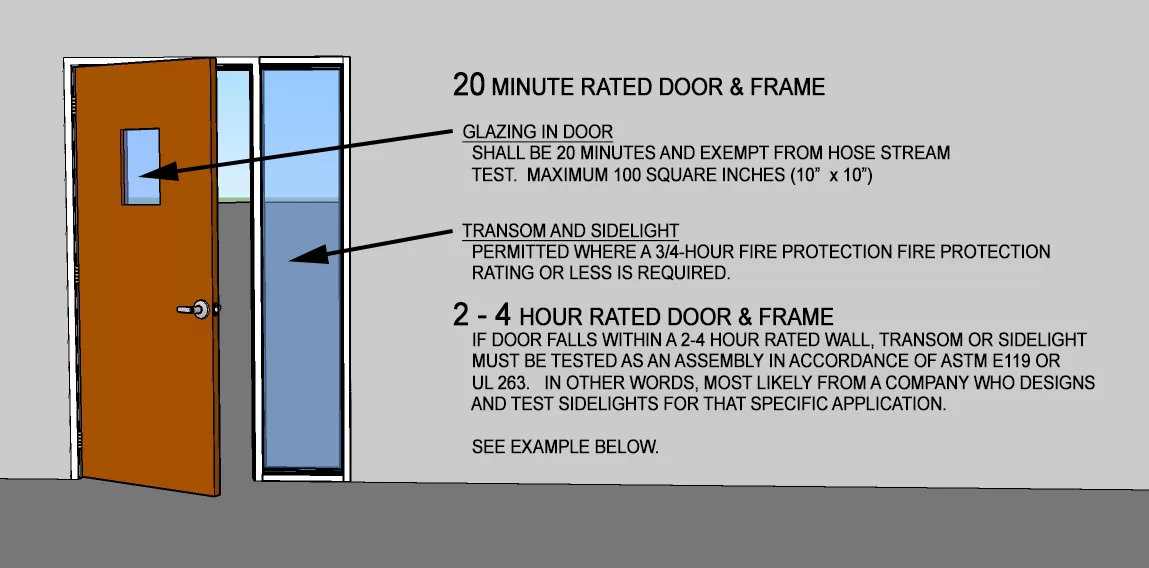How Can You Tell the Rating on a Fire-Rated Door?

As a professional fire rated door manufacturer, YK Commercial Door Company emphasizes the importance of understanding how to verify a door’s fire resistance rating. Whether you’re selecting rated doors for commercial buildings or evaluating a 1 hour fire rated door for a residential space, identifying the correct fireproof door rating system is critical to ensuring safety and compliance.
1. Check the Label on the Fire Door
One of the most direct ways to determine the fire rating of a door is by examining the label affixed to the fire door itself. Most fire rated doors include a clearly visible tag, usually placed on the hinge edge or top edge of the door, indicating essential specifications. This label typically includes:
- The fire resistance rating in minutes or hours (e.g., 20 minutes, 1 hour, 90 minutes)
- Manufacturer identification
- Testing and certification agency logos
- Model or serial number
If you’re wondering, “how can you tell the rating on a fire door,” start with the label—it’s your most reliable visual cue.
2. Review Product Documentation
Every certified door of fire protection should come with manufacturer-issued documentation. These materials often include datasheets, installation manuals, and technical guides outlining the exact fire resistance rating. For example, a 1 hour fire rated door will be clearly identified in both printed and digital documents as:
- One hour fire rated door
- 1 hour fire-rated door residential
- 1 hour rated fire door for commercial use
These documents also explain how the rating applies, such as within a 1-hour wall assembly, which is common in commercial architecture.
3. Verify Third-Party Certifications
Reputable fire door manufacturers like YK ensure that their fire doors are tested and certified by recognized third-party laboratories (e.g., UL, Intertek). These tests simulate real fire conditions to determine how long the door maintains integrity and insulation. You can request a copy of the certification report to confirm that the door fire rating in 1 hour wall or other specifications meet local code requirements.
4. Use Manufacturer’s Online Resources
YK Commercial Door Company offers full access to technical specifications, rating data, and model-specific certifications on our official website. Clients can easily search by product model to verify whether they are selecting a 60-minute fire door, 90-minute rated door, or even a Class 125 four-hour rated vault door. Accurate information is just a few clicks away.
5. Consult Fire Safety Professionals
In situations where documentation is missing or the label is unreadable, consult a certified fire inspector or fire safety engineer. These professionals are trained to assess door assemblies and may provide guidance aligned with fireproof doorrating system standards.
Understanding the 60-Minute Fire Door Rating – What the Code Really Says
One of the most confusing aspects of the fire door rating system is the requirement for 60-minute fire rated doors, especially when questions like these arise:
- Should the rating be 60 minutes or just 45?
- Does the vision panel require fire-protection or fire-resistance glazing?
- Can I exceed 100 sq. inches of glass in a 1 hour fire rated door?
- What are the limits for sidelites and transoms in a 60-minute door assembly?
Although the answers lie within the International Building Code (IBC), they are not always easy to interpret. This section breaks down the requirements based on door assemblies, glazing, and wall types, particularly from the 2025 IBC, with clarification from the 2006 and 2009 editions.
Fire Rated Door Requirements Under the IBC (2025)

A. 60-Minute Fire Doors in 1-Hour Rated Walls
According to Table 716.5 of the 2025 IBC, there are limited applications where a 60-minute door is required in a 1-hour wall. Most of these walls only need a 45-minute fire door or even a 20-minute door.
However, when a 1-hour fire barrier does require a full 60-minute fire rated door, the specifications for glazing size and glazing type become very strict.
Fire Door Vision Panel Size Limits
- Fire Protection Glazing (e.g., filmed ceramic, laminated ceramic, filmed wired glass, and specialty tempered glass) is limited to 100 sq. inches in the vision panel of a 60-minute door.
- Fire Resistance Glazing (e.g., products tested to ASTM E-119 such as SuperLite II-XL) has no size limitation, as long as it complies with the tested maximum dimensions (see Footnote ‘c’ in IBC Table 716.5). These allow architects to include larger panels in 60-minute doors while remaining code-compliant.
Important: Under the 2012 IBC, even in a fully sprinklered building, fire protection glazing is still limited to 100 sq. inches in the door vision panel.
Examples
- Photo 1: PYRAN Platinum F filmed ceramic was used for a stairwell’s 60-minute door vision panel. This material, being fire protection rated, is limited to 100 sq. inches.
- Photo 2: In a code-compliant 1-hour stairwell door with larger glazing, the architects used SuperLite II-XL 60, a fire resistance rated glazing tested to ASTM E-119, which allows exceeding the 100 sq. inch limit.
Sidelites and Transoms in 60-Minute Assemblies
The IBC also clearly differentiates between acceptable glazing for sidelites and transoms:
- Fire protection glazing (such as filmed ceramic and wired glass) is not allowed.
- Fire resistance glazing (ASTM E-119 tested units like SuperLite II-XL) is permitted and may be used to the full tested dimensions.
This distinction is critical for maintaining compliance in 1 hour fire-rated stairwells, egress corridors, and fire barrier walls.
Key Takeaways for Architects, Builders, and Fire Door Buyers
- When specifying 60-minute fire doors, always check the IBC tables for correct applications.
- Use ASTM E-119 fire resistance glazing when vision panel size needs to exceed 100 sq. inches.
- Avoid using fire protection glass in sidelites and transoms surrounding 60-minute doors.
- Always verify with a certified fire door manufacturer or fire protection consultant for code-specific guidance.
How Do You Determine the Right Rating for a Fire Door?

Understanding how fire door ratings work is essential for compliance and safety—yet it’s rarely straightforward. As Greg Harrington noted in NFPA 101: What Rating Do I Need for Fire Doors?, the right fire-protection rating for a door depends heavily on the fire-resistance rating of the surrounding barrier and the wall’s function. For example, a fire rated door in an exit enclosure differs in specification from one used in a corridor or shaft. At YK Fire Rated Doors Manufacturer, we help clients navigate these complexities with clarity and precision.
The fireproof door rating system is outlined clearly in NFPA 101 Table 8.3.3.2.2, where fire rated components like elevator hoistways, horizontal exits, and smoke barriers are matched with appropriate door protection ratings. However, confusion often arises when smoke partitions are misinterpreted as requiring a minimum resistance time. In reality, the fire door’s rating only becomes relevant if another section of the code requires a fire-rated barrier.
For example, if a wall has a 1-hour fire resistance rating, the required door protection might vary from 20 minutes to 1 hour, depending on its application. This is where knowledge of 1 hour fire rated door classifications becomes crucial. Whether it’s a one hour fire rated door for commercial corridors or a 1 hour fire-rated door residential application, the actual door fire rating in a 1 hour wall must be chosen based on life safety performance and code alignment.
YK’s range of 1 hour fire rated doors and 1 hour rated fire door solutions are tested and certified under standards like NFPA 252 and UL 10C. These tests assess fire protection ratings, which differ from fire resistance ratings assigned to structural barriers under ASTM E119. Though they may sound similar, they are distinct in measurement. This difference is crucial when evaluating whether a door of fire meets the necessary compliance standards in your specific environment.
Reading the Label: You Can Tell the Rating on a Fire Door By…
To ensure compliance, you can tell the rating on a fire door by examining the permanent label or marking affixed by the manufacturer. This label indicates the fire protection duration—such as 20, 45, 60, 90, or 180 minutes—and typically includes the test standard used (e.g., NFPA 252). If you’re unsure how can you tell the rating on a fire door, always look for labels that specify duration and certification body, often found on the hinge edge of the door or frame.
As a trusted manufacturer of fire rated doors, YK ensures that every product is clearly labeled, tested, and traceable, aligning with international codes and fireproof door rating system regulations. Whether your project requires fire rated doorfire assemblies for hospitals, rated doors for commercial high-rises, or fire doors for industrial applications, we provide verified solutions backed by technical guidance.
Final Thoughts
Determining the correct fire rating for a door is not just a technical requirement—it’s a critical life safety decision. At YK Fire Rated Doors Manufacturer, we help architects, builders, and safety professionals select compliant, certified, and cost-effective fire rated door systems for every building type. From 1 hour fire door designs to high-performance door of fire solutions, our mission is to protect people and property through precise engineering and rigorous testing.
For expert advice on selecting the right fire doors for your project—or to learn more about how can you tell the rating on a fire door—contact YK today. Our specialists are ready to support you every step of the way.

Pingback: The Difference Between Fire Door Ratings FD30 and FD60 - YK | Fire Doors | Fire Windows | Fire Shutters